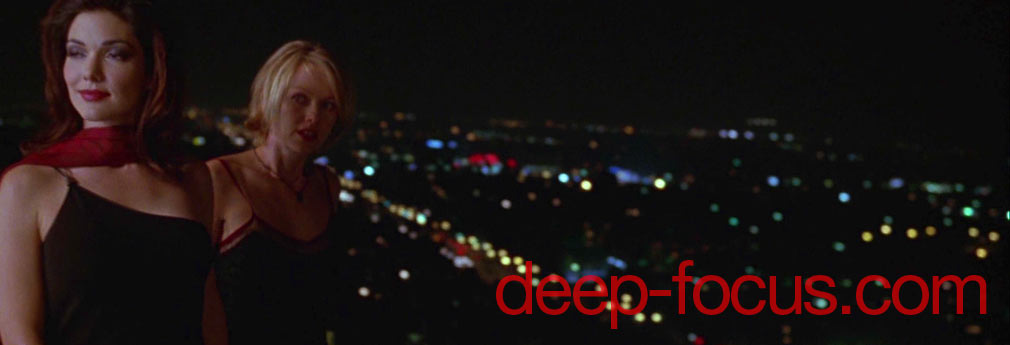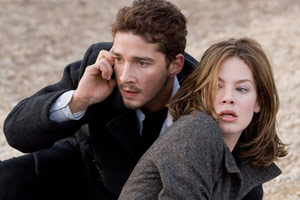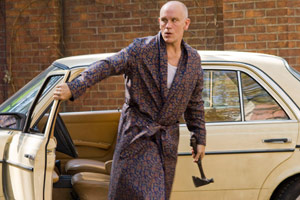« Baby Face (1933) | Main | The Double Life of Véronique (1991) »
Curse of the Golden Flower (2006)

Gong Li plus Chow Yun Fat sounds like some kind of superstar pairing, all right. Too bad it comes on the downslope of a precipitous decline in the watchability of director Zhang Yimou's work. Gong is the Empress and Chow her Emperor in this grand soap-opera pageant of color and sound that seems born more from a desire to see how closely Chinese cinema can hew to the high digital standard set by the Lord of the Rings movies than by any honest attempt at storytelling on a human scale.
Roughly the film's first half is given over to talky exposition. It's remarkable that a movie anchored by two of the greatest film stars of their generation should rely so heavily on their line readings than on physical performance. (To be fair, I should give Chow credit for the magisterial swagger he doles out in small doses, as though educated at the Toshiro Mifune School of Gruff Screen Presence.) But Golden Flower is lazy in its tell-don't-show narrative, filling us so full of backstory in the subtitles -- the Empress (somebody please wipe her brow) is sleeping with one of her sons, though she's not his birth mother; the Emperor respects the skills of but one of his three sons, though he fears the boy may one day turn against him; and the Emperor is slowly poisoning the Empress (this last bit is explained to us twice, just in case we miss the significance) -- that we can barely take in the film's ornately designed and elaborately lighted sets.
There's an intensity on screen that feels painstakingly planned and digitally amplified. The walls and hallways of the Imperial Palace are made up of swirls of color, all reds, purples and greens, and they glow as if the moldings are illuminated from within. (The effect is like an electric Van Gogh.) The film has the same picture-postcard prettiness as House of Flying Daggers, and that's not meant as a compliment. (Please note that I do mean to draw a distinction between the gorgeously realized alternate universes created by Hero and the hallucinatory Thomas Kincaid stylings of these two more recent pictures.) The push-and-pull between the rote royal-family intrigue and the feverish visual design is almost too much, nearly drowning the picture in a sea of self-generating kitsch.
And then, hey! Ninjas! Zhang kicks the increasingly Shakespearean proceedings up a notch with the sudden arrival on the scene of a small army of hyperactive black-clad refugees from the Imperial Xbox -- essentially a royal assassins' squad. And then those fierce sons-of-bitches are outmatched by another pop-up army of crack archers that doesn't take any shit from Ninjas. The different factions are stand-ins for a battle of wits between Emperor Husband and Empress Wife, and theyâll get a lot bigger before the movie is over. (It's like The War of the Roses writ very, very large.)
Zhang still has some artistic instincts. I loved the filmâs opening, which involves a striking three-dimensional title and then a sequence that cross-cuts between what looks like scores of young women wearing tiny little half-corsets that push their breasts up underneath their chins preparing for some kind of ceremony (representing Woman, I think) and the pounding hoofbeats of the arriving Emperor and his entourage (representing Man). After thousands of his subjects have massed, Triumph of the Will style, to honor his presence, he suddenly calls the whole thing off, sending word that he wonât be coming inside after all and instead means to meet privately with the members of his family. Itâs a lavish and promising way to open a film on an epic scale â but from there itâs talk talk talk.
The thunderous, CGI-enhanced armies that completely overtake the filmâs final act feel more like a sop to the marketplace than any kind of artistic expression. You liked the fearsome storm of arrows flying overhead at the end of Hero? Wait until you see the massive quantities of spears being chucked through space near the end of Golden Flower. You liked the gritty, matter-of-fact brutality that made Middle Earth feel like an awesome and dangerous place? Wait until you see what a couple of hooked blades at the end of long chains can do to a Chinese girl. And with millions of bright yellow chrysanthemums covering the Imperial Courtyard, can you imagine what some judicious splattering of blood could do for the color palette? (There is one shot I really liked, which showed the Imperial janitorial crew cleaning up the bloody mess with casual efficiency like theyâre rolling up the tarp after a rainstorm at Giants Stadium.) The violence isnât executed with cynicism so much as a shrug â this is the way we make movies these days, so what are you gonna do? Itâs just a shame to see one of the more grandly expressive filmmakers of recent decades â his film Ju Dou brought some of the glories of Technicolor back to the screen for international audiences after the last Technicolor labs in Hollywood were long gone â working in so superficial and mechanical a style. C
0 TrackBacks
Listed below are links to blogs that reference this entry: Curse of the Golden Flower (2006).
TrackBack URL for this entry: http://www.deep-focus.com/pcgi-bin/MT/mt-tb.cgi/126





Leave a comment